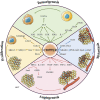Copper homeostasis and cuproptosis in tumor pathogenesis and therapeutic strategies
- PMID: 37767404
- PMCID: PMC10520736
- DOI: 10.3389/fphar.2023.1271613
Copper homeostasis and cuproptosis in tumor pathogenesis and therapeutic strategies
Abstract
Copper is an indispensable micronutrient for the development and replication of all eukaryotes, and its redox properties are both harmful and beneficial to cells. An imbalance in copper homeostasis is thought to be involved in carcinogenesis. Importantly, cancer cell proliferation, angiogenesis, and metastasis cannot be separated from the effects of copper. Cuproposis is a copper-dependent form of cell death that differs from other existing modalities of regulatory cell death. The role of cuproptosis in the pathogenesis of the nervous and cardiovascular systems has been widely studied; however, its impact on malignant tumors is yet to be fully understood from a clinical perspective. Exploring signaling pathways related to cuproptosis will undoubtedly provide a new perspective for the development of anti-tumor drugs in the future. Here, we systematically review the systemic and cellular metabolic processes of copper and the regulatory mechanisms of cuproptosis in cancer. In addition, we discuss the possibility of targeting copper ion drugs to prolong the survival of cancer patients, with an emphasis on the most representative copper ionophores and chelators. We suggest that attention should be paid to the potential value of copper in the treatment of specific cancers.
Keywords: cancer therapeutics; carcinogenesis; copper homeostasis; cuproptosis; drug.
Copyright © 2023 Bian, Zheng, Su, Chang, Yu, Bao, Xin and Jiang.
Conflict of interest statement
The authors declare that the research was conducted in the absence of any commercial or financial relationships that could be construed as a potential conflict of interest.
Figures



Similar articles
-
Targeting cuproptosis for cancer therapy: Focus on the anti-tumor immune system.Cancer Pathog Ther. 2024 Jul 27;3(3):226-243. doi: 10.1016/j.cpt.2024.07.005. eCollection 2025 May. Cancer Pathog Ther. 2024. PMID: 40458306 Free PMC article. Review.
-
Regulatory roles of copper metabolism and cuproptosis in human cancers.Front Oncol. 2023 Mar 23;13:1123420. doi: 10.3389/fonc.2023.1123420. eCollection 2023. Front Oncol. 2023. PMID: 37035162 Free PMC article. Review.
-
Cuproptosis: A novel therapeutic target for overcoming cancer drug resistance.Drug Resist Updat. 2024 Jan;72:101018. doi: 10.1016/j.drup.2023.101018. Epub 2023 Nov 11. Drug Resist Updat. 2024. PMID: 37979442 Review.
-
Cuproptosis: mechanisms and links with cancers.Mol Cancer. 2023 Mar 7;22(1):46. doi: 10.1186/s12943-023-01732-y. Mol Cancer. 2023. PMID: 36882769 Free PMC article. Review.
-
Exploring cuproptosis as a mechanism and potential intervention target in cardiovascular diseases.Front Pharmacol. 2023 Aug 11;14:1229297. doi: 10.3389/fphar.2023.1229297. eCollection 2023. Front Pharmacol. 2023. PMID: 37637426 Free PMC article. Review.
Cited by
-
Identification of Copper Homeostasis-Related Gene Signature for Predicting Prognosis in Patients with Epithelial Ovarian Cancer.Cancer Inform. 2024 Aug 13;23:11769351241272400. doi: 10.1177/11769351241272400. eCollection 2024. Cancer Inform. 2024. PMID: 39139301 Free PMC article.
-
The emerging role of cuproptosis in spinal cord injury.Front Immunol. 2025 Jun 16;16:1595852. doi: 10.3389/fimmu.2025.1595852. eCollection 2025. Front Immunol. 2025. PMID: 40589743 Free PMC article. Review.
-
Drug Repurposing of New Treatments for Neuroendocrine Tumors.Cancers (Basel). 2025 Jul 28;17(15):2488. doi: 10.3390/cancers17152488. Cancers (Basel). 2025. PMID: 40805187 Free PMC article. Review.
-
Cytotoxic Activity of the Red Grape Polyphenol Resveratrol against Human Prostate Cancer Cells: A Molecular Mechanism Mediated by Mobilization of Nuclear Copper and Generation of Reactive Oxygen Species.Life (Basel). 2024 May 9;14(5):611. doi: 10.3390/life14050611. Life (Basel). 2024. PMID: 38792632 Free PMC article.
-
Stem cell status and prognostic applications of cuproptosis-associated lncRNAs in acute myeloid leukemia.Front Cell Dev Biol. 2025 Jan 14;12:1549294. doi: 10.3389/fcell.2024.1549294. eCollection 2024. Front Cell Dev Biol. 2025. PMID: 39877157 Free PMC article.
References
Publication types
LinkOut - more resources
Full Text Sources

